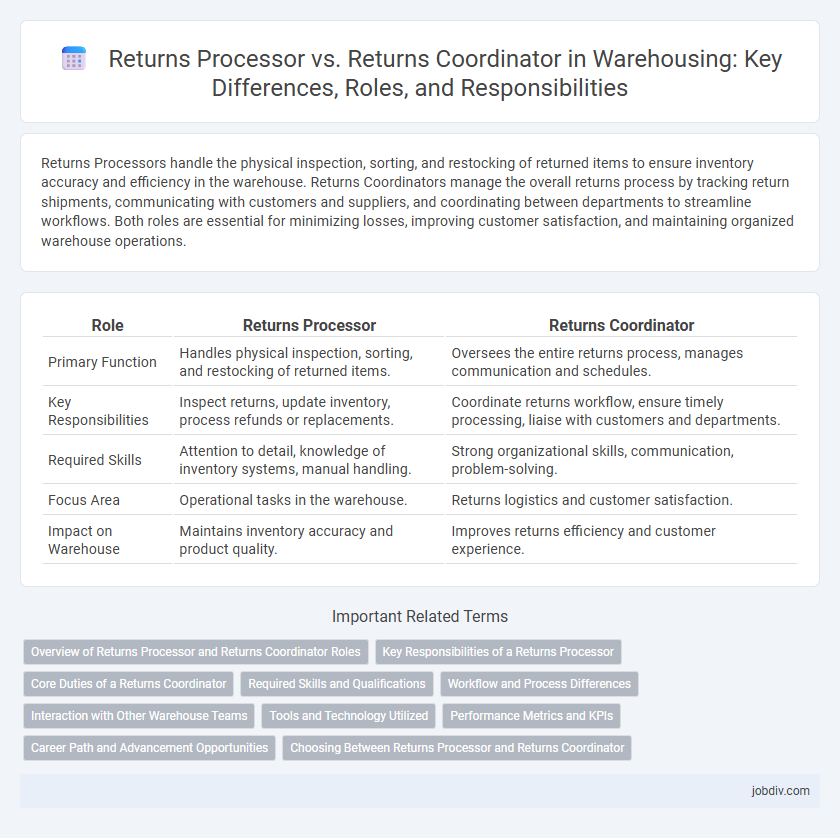Returns Processors handle the physical inspection, sorting, and restocking of returned items to ensure inventory accuracy and efficiency in the warehouse. Returns Coordinators manage the overall returns process by tracking return shipments, communicating with customers and suppliers, and coordinating between departments to streamline workflows. Both roles are essential for minimizing losses, improving customer satisfaction, and maintaining organized warehouse operations.
Table of Comparison
| Role | Returns Processor | Returns Coordinator |
|---|---|---|
| Primary Function | Handles physical inspection, sorting, and restocking of returned items. | Oversees the entire returns process, manages communication and schedules. |
| Key Responsibilities | Inspect returns, update inventory, process refunds or replacements. | Coordinate returns workflow, ensure timely processing, liaise with customers and departments. |
| Required Skills | Attention to detail, knowledge of inventory systems, manual handling. | Strong organizational skills, communication, problem-solving. |
| Focus Area | Operational tasks in the warehouse. | Returns logistics and customer satisfaction. |
| Impact on Warehouse | Maintains inventory accuracy and product quality. | Improves returns efficiency and customer experience. |
Overview of Returns Processor and Returns Coordinator Roles
Returns Processors specialize in inspecting, sorting, and restocking returned merchandise, ensuring accurate documentation and compliance with quality standards in warehouse operations. Returns Coordinators manage the logistics and communication between warehouse teams, vendors, and customers, coordinating the flow of returns to optimize efficiency and reduce processing times. Both roles are essential for maintaining inventory accuracy and improving reverse logistics performance within warehousing environments.
Key Responsibilities of a Returns Processor
A Returns Processor primarily manages the inspection, sorting, and documentation of returned products to ensure accurate inventory updates and quality control. This role involves coordinating with warehouse staff to process returns efficiently, inspecting items for damage or defects, and ensuring proper disposition according to company policies. Emphasis is placed on data entry accuracy, timely updating of return statuses in warehouse management systems, and adherence to return protocols to optimize reverse logistics.
Core Duties of a Returns Coordinator
A Returns Coordinator manages the entire reverse logistics process, overseeing the receipt, inspection, and disposition of returned goods to ensure accurate inventory updates and compliance with company policies. They coordinate communication between warehouses, transportation, and customer service teams to streamline returns processing and resolve discrepancies. By analyzing return reasons and maintaining detailed records, Returns Coordinators support continuous improvement in product quality and customer satisfaction.
Required Skills and Qualifications
A Returns Processor requires strong attention to detail, proficiency in inventory management software, and basic data entry skills to efficiently handle returned products and update records. A Returns Coordinator demands advanced organizational abilities, excellent communication skills, and experience in logistics coordination to manage return workflows, liaise with multiple departments, and optimize return policies. Both roles benefit from a solid understanding of warehouse operations and quality control standards.
Workflow and Process Differences
A Returns Processor primarily handles the physical inspection, sorting, and restocking of returned inventory, ensuring accurate data entry into warehouse management systems for inventory updates. In contrast, a Returns Coordinator oversees the entire returns workflow, including tracking return authorizations, coordinating with suppliers or customers, and resolving discrepancies to streamline the return process. The Returns Coordinator ensures communication across departments and timely processing, while the Returns Processor focuses on executing the operational tasks within the returns workflow.
Interaction with Other Warehouse Teams
A Returns Processor primarily focuses on inspecting, sorting, and restocking returned items, requiring frequent interaction with inventory management and quality control teams to ensure accurate product status updates. A Returns Coordinator oversees the returns workflow, communicating closely with customer service, logistics, and warehouse operations teams to resolve discrepancies and streamline the return process. Effective collaboration between these roles and other warehouse departments enhances return accuracy and accelerates inventory turnover.
Tools and Technology Utilized
Returns Processors primarily utilize warehouse management systems (WMS), barcode scanners, and inventory tracking software to efficiently inspect, sort, and recondition returned items for restocking. Returns Coordinators employ analytics platforms, customer relationship management (CRM) tools, and communication software to oversee return workflows, coordinate between departments, and resolve return disputes. Both roles leverage integrated return merchandise authorization (RMA) systems to streamline return authorizations and data accuracy throughout the reverse logistics process.
Performance Metrics and KPIs
Returns Processors are evaluated based on metrics such as the accuracy rate of inspected returned goods, processing time per return, and the percentage of returns correctly categorized to minimize errors and delays. Returns Coordinators focus on KPIs including overall returns volume managed, resolution time for return disputes, and coordination efficiency between departments to optimize workflow and reduce bottlenecks. Both roles rely on comprehensive tracking of Return Merchandise Authorization (RMA) cycle times and customer satisfaction scores to measure performance in the returns management process.
Career Path and Advancement Opportunities
Returns Processors typically begin their careers handling the physical inspection and sorting of returned products, gaining hands-on experience in quality control and inventory management. Returns Coordinators advance by overseeing the entire returns workflow, coordinating between departments, and managing documentation and reporting, which develops skills in logistics and supply chain management. Career growth from Processor to Coordinator often leads to higher managerial roles in warehouse operations or supply chain analysis, emphasizing leadership and strategic planning expertise.
Choosing Between Returns Processor and Returns Coordinator
Choosing between a Returns Processor and a Returns Coordinator depends on the scale and complexity of your warehouse operations. A Returns Processor specializes in handling individual return transactions efficiently, focusing on inspections, restocking, and data entry, ideal for high-volume, routine returns. In contrast, a Returns Coordinator manages the overall returns workflow, coordinating between departments, analyzing return trends, and implementing process improvements, which is crucial for warehouses aiming to optimize return logistics and customer satisfaction.
Returns Processor vs Returns Coordinator Infographic

 jobdiv.com
jobdiv.com